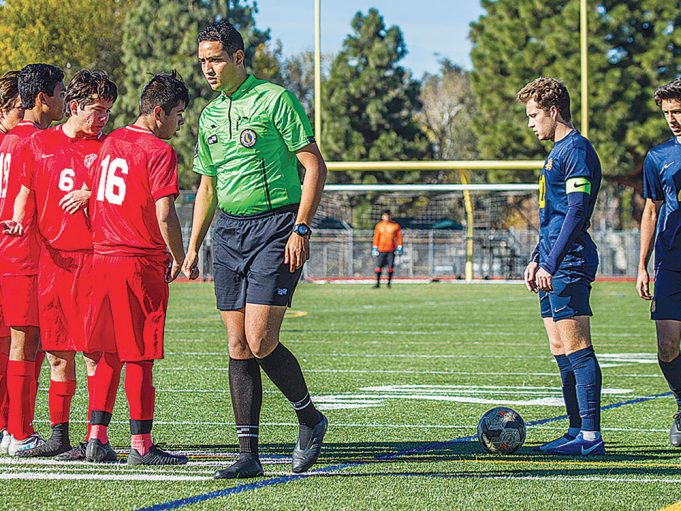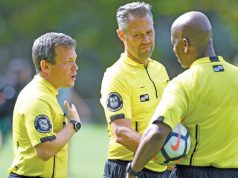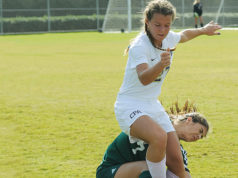F
ree kicks from just outside the penalty area can determine the outcome of a game. They can be so critical that teams have multiple choreographed set pieces to execute in such situations. The officiating team also has to execute in these moments because effective officiating demands preparation and teamwork.
While walking the field in the pregame, it makes sense to stop outside the penalty area and discuss with the crew how to manage free kicks that target the goal. The crew must focus on possible encroachment, fouls or misconduct in the wall, offside, and a possible goal. Successful crews delegate roles differently, but all should discuss their roles beforehand.
When the kick is taken in AR1’s half of the field, AR2 should be at the halfway line to observe fouls and misconduct the center referee (CR) cannot see, and to become the lead referee if a fast breakaway results from the kick. The responsibilities are reversed if the kick takes place in AR2’s half of the field.
The following situations involve direct free kicks (DFK) in either of the assistant referees’ (AR) half of the field:
Quick kick.
After the CR blows the whistle, the CR needs to indicate direction and yield an opportunity for a quick kick taken inside AR1’s half of the field. If the CR senses a quick restart, he or she watches for opposing players encroaching and a stationary ball. An alert AR1 needs to disregard any chaos near the ball and focus on offside and an ensuing ball that enters the goal area. AR2, positioned at the halfway line, should look for handling in the wall or misconduct. Kudos to any member of the crew who, before the game, identifies the tendency of one of the teams to take those restarts quickly.
Ceremonial restart in either half of the field.
The CR blows the whistle, indicates direction and realizes that the attacking team asks for 10 yards. After seeing that the ball is placed at the spot of the foul, the CR can then quickly gauge the willingness of the defenders to yield 10 yards. Compliant players might simply need a cue such as “mark your wall at the penalty kick spot.” Many times, however, the defending team will protest the measurement of yards, often confusing it with inches or feet. After the kicker places the ball, the CR must not turn his or her back to the ball because a clever attacker will move the ball to a more fortuitous placement. Instead, the CR can walk backward to a spot 10 yards from the ball. Then, the CR embodies a stanza in the Pink Floyd hit, as “another brick in the wall.” The players follow suit, and the CR can turn his or her attention to the keeper.
Many teams entrust their keeper to set the walls. This can be exposed with a quick kick, but in ceremonial restarts, the keeper must be granted sufficient time to set the wall. The CR should verify that the keeper is ready by either observing a ready position or by simply asking the keeper if he or she is ready.
Prior to initiating the ceremonial restart by blowing the whistle, the CR positions behind the kicker, toward the middle of the field and facing the wall.
The following relates to indirect free kicks (IFK). The CR indicates IFK by raising his or her arm. The CR then can get into a position to make sure the ball has been kicked after the CR blows his or her whistle. Additionally, the CR can watch for encroachment from a collapsing defensive wall. At least one member of the officiating crew must see that the ball has been touched by a second player before it enters the goal. The AR is responsible for offside and the validity of a goal.
Ceremonial restarts, whether DFK or IFK adjacent to the penalty area in AR1’s half of the field.
When the ball is placed at the spot of the foul, the CR can position toward the middle of the field, angled slightly behind the kicker. This gives the CR a nice, wide angle to see the wall and the goal. In this case, the defenders will be inside the goal area, which allows AR1 to deal with offside and goals and to move quickly to the goal line when the kick is taken.
When the ball is placed in the quadrant of AR2, the CR can stand toward the AR1 side of the field to get the same wide angle, from a different perspective. In this case, the defenders will be inside the goal area, which allows AR2 to be deal with offside and a possible goal.
“Now what?” is one of the worst questions to ask on a soccer field. High-level teams don’t play “now what?” soccer. They understand their options before the ball is on their feet. Shouldn’t high-level crews — the third team on the field — have the same preparedness when officiating a key moment in the game with a well-executed set piece?
What's Your Call? Leave a Comment:
Note: This article is archival in nature. Rules, interpretations, mechanics, philosophies and other information may or may not be correct for the current year.
This article is the copyright of ©Referee Enterprises, Inc., and may not be republished in whole or in part online, in print or in any capacity without expressed written permission from Referee. The article is made available for educational use by individuals.


















